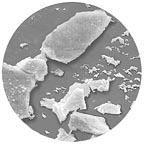
Where complete removal of silica is required, various combinations of reverse osmosis (RO) and/or ion exchange processes are used. The current state-of-the-art technology includes both multiple membrane and multiple ion exchange steps, and can produce reactive silica concentrations in the neighborhood of 0.1 ppb.
Chemical Precipitation
Silica almost never precipitates as SiO2. Silica scale almost always contains a divalent (or trivalent) cation. Although calcium silicate is quite insoluble, this compound does not form rapidly except at very high temperatures. Although aluminum salts can be used to precipitate silica, the consequences of leaving a substantial aluminum residual in the product water makes this process undesirable. The conventional method of precipitating silica has always been co-precipitation with magnesium.Since silica becomes part of the magnesium precipitant, some means of adding already precipitated magnesium (magnesium oxide) or of precipitating magnesium in situ is used. In situ precipitation works much better than already precipitated magnesium, probably due to surface area of the precipitant and proximity to a silica molecule.
The addition of soluble magnesium salts (such as MgCl2) often is desirable due to an increase of total dissolved solids. Even though it is less effective, MgO is more often used. The advantage of MgO is that it adds little or no dissolved solid to the water.
Temperature and pH also have important effects on silica removal by precipitation. The precipitation mechanism occurs faster and more completely at high temperatures. The pH must be high enough to cause magnesium to precipitate but not so high as to make the precipitant resoluble.
Reverse Osmosis Systems
RO systems also can be used to reduce silica concentration. Although cellulose acetate and early thin-film composite materials only provided moderate silica rejection, newer materials reject silica quite well. The mechanism of removal probably is by hyper-filtration, but also is related to degree of ionization since silica is more completely removed at a high pH. Since silica is concentrated by the membrane in the reject stream, silica solubility can be an important consideration. RO systems currently are unable to achieve as complete removal of reactive silica as ion exchange, but are far better at removing various forms of non-reactive silica.E Cells
E Cells are electrodialysis stacks where the water-flow channels are filled with ion exchange resin. The mechanism of removal probably is that the resin first exchanges for various ions (including silica), slowing them down, and then allowing them to be pulled through the membranes. Since silica is weakly ionized, a higher current density is needed for a high percentage of silica removal. The E Cell process currently is more expensive than RO for bulk removal of ions and suffers the same inability as ion exchange to remove non-reactive silica. However, it is competitive with RO and ion exchange technology for polishing and offers a perceived advantage over ion exchange, in that its use does not involve handling of strong mineral acids and bases. Still, the lowest silica residuals currently achievable are produced by ion exchange resins.Ion Exchange Technology
All strongly basic ion exchange resins have the ability to split salts. This means that they can remove weakly ionized species such as carbon dioxide and silica. Although hydroxides form strong base anion resins, preference for silica is much lower than for sulfates and chlorides; it is significantly greater than for hydroxide. There is pretty good evidence that only when in the hydroxide form, does strong base anion resin exhibit any preference for silica. When in the hydroxide form, preference for silica and for alkalinity are similar (at least we know that silica break generally occurs at about the same percentage exhaustion as alkalinity break). In the chloride form, or any other salt form, strong base anion resin has zero preference for silica (probably because silica is nonionized at typical raw water pH), although it still can be used for alkalinity removal.
This suggests that silica is not exchanged in the same way as other anions.
Desilicizers
An anion desilicizer is a “poor man's” demineralizer, consisting of a strong cation exchanger in the sodium form (a water softener), followed by a strong base anion exchanger in the hydroxide form. Thank goodness there are not too many of these critters around anymore. They have most of the disadvantages of a demineralizer and few of the advantages. However, they do remove silica along with the other anions.
Over the years, more than one engineer has wondered if it might be possible to operate a desilicizer at a real small caustic dose (or perhaps brine plus caustic) and use the anion resin as a dealkalizer while still removing some silica. This would avoid the excess causticity created by the complete anion exchange for hydroxides. This was tried and the results were quite interesting. As long as the resin had enough hydroxide exchange sites to remove all the anions, silica was well removed. As soon as the hydroxide sites were depleted, the resin dumped the silica. By the time the hydroxide concentration was substantially reduced in the product water, all the silica had dumped. There was no net removal.
ND



Report Abusive Comment